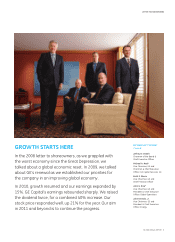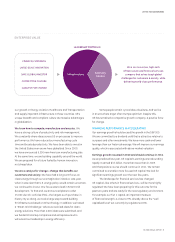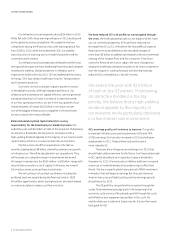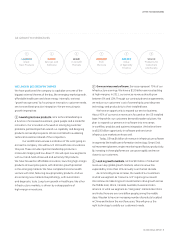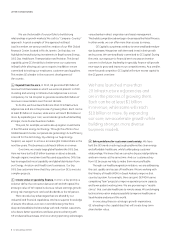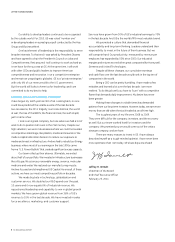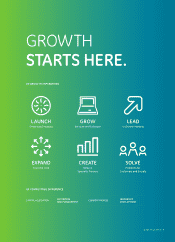GE 2010 Annual Report Download - page 6
Download and view the complete annual report
Please find page 6 of the 2010 GE annual report below. You can navigate through the pages in the report by either clicking on the pages listed below, or by using the keyword search tool below to find specific information within the annual report.4 GE 2010 ANNUAL REPORT
LETTER TO SHAREOWNERS
Our Infrastructure earnings were about $14 billion in 2010.
While flat with 2009, these earnings will grow in 2011 and beyond
as the global economy strengthens. We outperformed our
competitors during the financial crisis, with earnings about flat
from 2008 to 2010, while theirs declined 15%. Our stability
was a function of a strong service model that performed for
customers and investors.
Our Infrastructure businesses are well positioned for long-
term growth because we have leadership franchises and compete
in attractive markets. Global investment in infrastructure is
expected to be $4 trillion by 2015. GE has leadership franchises
in Energy, Oil & Gas, Water, Healthcare, Aviation, Transportation
and Consumer products.
Over time, we look to sustain organic growth in excess
of the global economy, with high margins and returns. Our
Infrastructure businesses are capital-efficient, and we generate
a substantial amount of cash in excess of investment needs.
In our key operating metrics, we are in the top quartile of our
industrial peers. At nearly $100 billion in revenue, we are
one of the biggest Infrastructure companies in the world, and
we are certainly the most profitable.
Balanced and disciplined capital allocation is a key
responsibility for the Board and your leadership team. We
ended the year with $19 billion of cash at the GE parent. Maintaining
an attractive dividend is the top priority. We believe that a
high-yielding dividend appeals to the majority of our investors and
is particularly attractive in a low interest rate environment.
We have announced five acquisitions in the last six
months, totaling about $8 billion, that will accelerate our growth
in Infrastructure. We will be disciplined in our acquisitions. They
will increase our competitiveness in industries we know well.
We target investments in the $500 million- to $3 billion-range with
returns that exceed our cost of capital. In this way, we reward
GE investors as we scale up these investments.
We will continue to buy back our shares, including the
preferred stock we issued during the financial crisis in 2008.
We will be opportunistic about buying back our own stock based
on returns but plan to reduce our float over time.
We have reduced GE’s risk profile, as we navigated through
the crisis. We hold substantial cash on our balance sheet, have
cut our commercial paper by 60% and have reduced our
leverage from 8:1 to 5:1. We believe the most difficult losses in
financial services are behind us. We recorded charges of
more than $3 billion to address risk related to the environmental
cleanup of the Hudson River and the consumer “Grey Zone”
claims for financial services in Japan. We have changed our
employee healthcare and pension plans to be more competitive
over the long term. Looking forward, we have dramatically
reduced GE’s vulnerability to “tail risk” events.
GE’s earnings quality will continue to improve. Our goal is
to maintain Infrastructure earnings between 60% and 70%
of GE’s earnings. Our tax rate increased in 2010 and will grow
substantially in 2011. These elements should create a
more valuable GE.
There are a few things we are working on in 2011 that
should help build momentum for the future. Our financial strength
in GE Capital should put us in a position to pay a dividend to
the parent in 2012. We worry about inflation and have increased
resources on material productivity and pricing to offset that
threat. We are in a particularly heavy period of R&D investment
in Aviation that will keep its earnings flat this year. However,
Aviation has a record high backlog and its earnings growth
should return by 2012.
The GE portfolio can perform for investors through the
cycles: financial earnings surge back in the beginning of an
economic cycle; service offers steady growth through the cycle;
and infrastructure equipment grows later in the cycle. No
matter what your investment thesis may be, the next few years
look good for GE!
We ended the year with $19 billion
of cash at the GE parent. Maintaining
an attractive dividend is the top
priority. We believe that a high-yielding
dividend appeals to the majority of
our investors and is particularly attractive
in a low interest rate environment.



